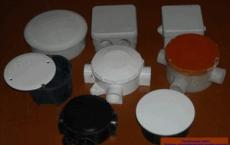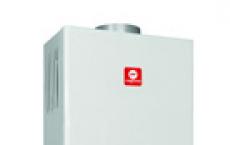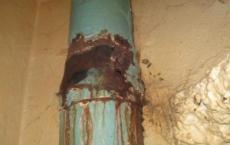Alternative heating of country house options. Options and schemes for the implementation of alternative heating private house
Owners of apartments, using centralized heating, think about how to install thermal countersto save in the cold. For the owner country cottage or manor issue of saving is to find the cheapest sources for getting heat. Many efficient owners prefer to switch to alternative heating of a private house in order to become completely non-volatile.
From traditional sources of heat, many years used for heating, you can refuse. Surprisingly, it is quite real. Many ardent opponents claim that it is impossible to replace natural resources with environmentally friendly analogs.
An alternative is the energy of the sun, the strength of the wind, the heat hidden in the bowels of the earth, the waste products of man's production and life. Such options are relevant in the modern world, given the general pollution of the environment.
Alternative sources are able to provide vacation home electricity and heat energy
Another significant advantage is tangible savings when using environmental sources of spontaneously renewable energy. At first glance it seems that this is unreasonably expensive and is unlikely to pay off. In more detail understanding the features of each method, you can see that the eco project pays off in 4-7 years, and then there are only the current costs of maintaining the used mechanisms in working order.
The possibility of a full replacement of the conventional fuel with an alternative is proved not by one real example. Homeowners around the world resort to environmental options for heating. At us - only units are solved to replace cardinally the habitual fuel, becoming more expensive every year.
Image Gallery
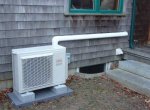
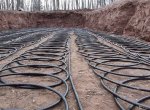

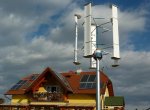

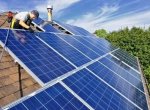
![]()
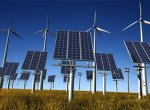
The main problem of eco-fuel - significant capital investment at the initial stage. After all, you first need to calculate in detail the amount of energy needed for a particular house or cottage. Then find out which type of eco-resources is most beneficial in a particular locality. Further, it is necessary to make a plan for the location of equipment generating energy, to buy everything necessary and to install.
If all these issues are dealt with by the appropriate specialists, the final cost of eco heating will be very high. To save money, you can try to do it yourself. For this it is necessary to plunge headlong into the subject alternative sources energy to refuse to attract outside help. In this case, the cost of the project will be several times cheaper.
It is the second option that many home owners choose. Their practice proves that it is quite possible to become energy-independent. You can completely or partially replace the traditional fuel - it all depends on the size of home ownership, financial capacity at the initial stage, the selected heating option.
Image Gallery
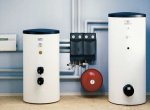

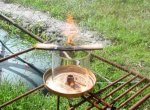
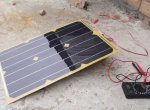
A strong wind will warm the house
Very successful as an alternative source for heating a country house you can use the wind energy. This resource can not be exhausted. It has the property of renewing. To use the power of the wind, you need a special device called a windmill.
The principle of using wind power
To convert wind power into an alternative source of heating, a wind turbine is needed. They are vertical and horizontal, depending on the axis of rotation. There are many manufacturers offering their models to customers.
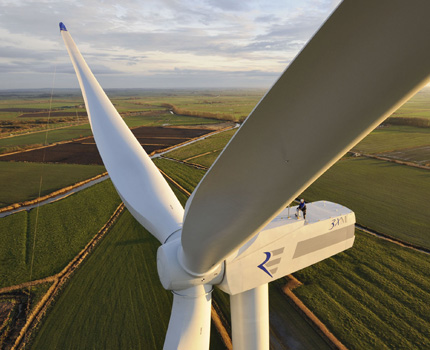
Wind power plants are with a horizontal and vertical axis of rotation. Great performance in horizontally oriented
The cost depends on the material, the size of the installation and the power. Also, you can build wind generator on their own, using improvised materials.
Any windmill consists of such components:
- blades;
- masts;
- weather vanes to catch wind direction;
- generator;
- controller;
- accumulator batteries;
- inverter.
The principle of operation of the wind power plant is based on the strength of the wind rotating the blades of the windmill. The blades attached to the mast are high above the ground. The higher, the higher the productivity. So, to supply one house there is enough height of 25 m.
Rotating blades drive the rotor of the generator. It begins to produce a three-phase alternating current, which requires further changes. This current flows to the controller, where it is converted to a constant current. It is used to charge the batteries.
Passing through the batteries, the current is equalized and fed to the inverter, where it converts to a single-phase alternating current of 50 Hz and a voltage of 220 volts. Now it can be used for domestic needs, in an electric heating system.
Image Gallery


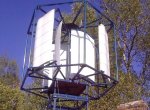
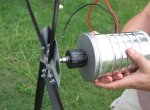
Features of the location of windmills
Wind farms are able to work under certain conditions. First, the wind generator is a rather voluminous structure, requiring an impressive area for the device. A small device is not able to meet energy needs. Its height should exceed a minimum of 10 m surrounding houses, trees and other structures, and power lines and other facilities should be located 100 meters from the windmill. This requirement is not always feasible - not all owners of private houses have personal plots of sufficient land.
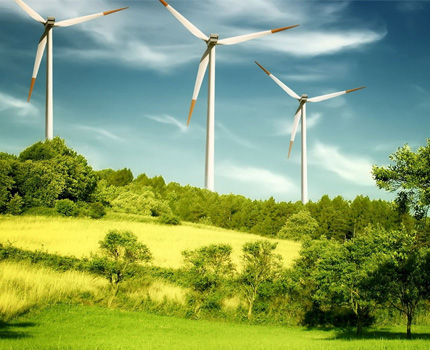
Windmills are best placed on a hill, a hill, away from trees and buildings - at least 100 meters
Secondly, it is good when the considered terrain has good wind potential - a hill or a steppe zone. To start the generator will require a wind speed of 2 m / s. Many models of wind systems, designed for use by private households, are able to fully cover the demand for electricity.
Thus, a 1.5 kW wind turbine can generate 100-200 kWh per month depending on the time of the year. If the height of the mast is increased, then the productivity will be more than 2 times. But this will require additional costs for installation and consumables. Life time wind power averages 20 years.
The energy of the Earth is free to heat the house
One of the alternative heating systems is geothermal. It is based on the use of the energy of the Earth. This is the heat of the earth, groundwater, ambient air, converted by heat pumps (TH). It is important that the temperature of the medium used by the installation be above zero.
The device and principle of operation of the heat pump
The operation of the geothermal system requires the electricity used to transfer the received heat. The heat pump, using 1 kW, produces from 2 to 6 kW of heat.
The basic principle of VT operation is to collect heat, convert it and transfer it to the heating circuit. This is realized thanks to the device itself.
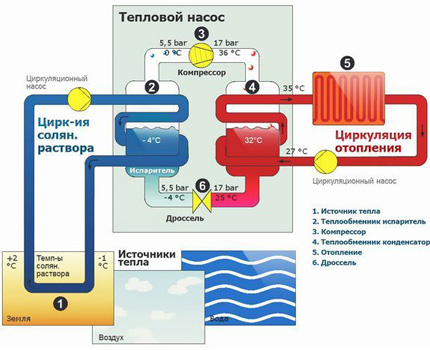
The cheapest way is to install an air-to-air heat pump. If you build it yourself, then you will need minimal financial investments
ТН consists of 3 closed circuits, involved in the process of obtaining heat for heating a private house:
- external - designed to take heat from sources. Antifreeze or brine is circulating along the contour;
- internal - filled with refrigerant, more often freon;
- heating circuit filled with coolant.
The Freon filling the inner contour is heated by the heat coming from the outer circuit. Having a low boiling point, it turns into gas in the first heat exchanger-evaporator. Then it enters the compressor, where it compresses, resulting in a lot of heat, and the temperature of the gas itself increases manifold - up to 65 degrees.
Further, the gaseous freon enters the next heat exchanger, called the condenser, where it leaves its heat. Freon, leaving most of the heat, comes under pressure on the discharge valve. Here the pressure drops sharply, the refrigerant cools and, after taking a liquid state, again enters the evaporator.
The heat left by the freon in the condenser heats the liquid circulating in the heating system of the house. If this system provides for the installation of warm floors, it is possible to achieve the most efficient heating at minimal cost.
To make the simplest version of the heat pump is easy with your own hands. To do this, you will actually need junk items, cheaply purchased equipment and, of course, patience. We present the scheme of a thermal system with the collection of heat energy in a well buried in dolomite.

The design of heat pumps has much in common. Traditional components: 1 - compressor; 2 - the condenser; 3 - evaporator; 4 - ТРВ, i.е. thermostatic valve (+)
The evaporator of the system in question is connected to an energy-absorbing well.
Image Gallery
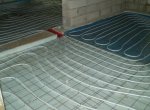
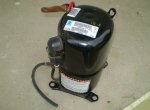
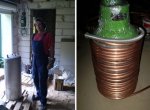
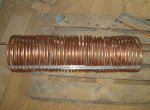
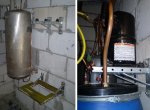
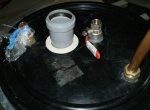
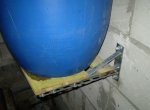
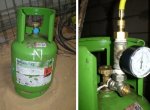
Feasibility of using TH
Heat pumps - TH, taking heat from the environment, are different. It all depends on the type of environment used as a source of heat intake and the type of coolant used. Accordingly, these types of TN are distinguished:
- air-to-air;
- water-to-air;
- water-to-water;
- soil-water.
The first two types of pumps are used in air heating systems, and the second two types are used in systems with a liquid coolant.
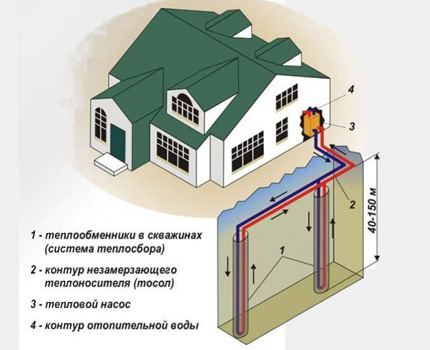
The vertical version of the heat pump is the most efficient in obtaining the energy of the earth, but it is the most expensive
The most economically viable option is the use of water-to-water. This option is advisable to use if near the house there is an ice-free reservoir into which pipes for heat collection are laid. The heat pump allows to receive 30 W of heat with 1 m of the pipeline. Depending on the area of private households and energy requirements, it will be necessary to lay the appropriate number of pipes.
Pumps that use air will not replace traditional heating in regions with a harsh climate. As for the heat extracted from the ground, this is a very expensive project. Use a horizontal geothermal field device, vertical and cluster drilling. In the horizontal version, it is necessary to build a geothermal field to a depth greater than the freezing level. This is about 1.5-2 m. The area of this field is impressive - from 200 m 2.
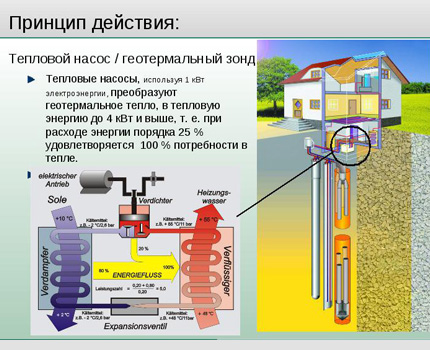
ТН are able to replace the usual fuel in the heating system, ensuring full energy independence for the country house
To implement the vertical and cluster project, drilling at a considerable depth will be required, using drilling rigs. This is a very expensive service. The equipment of this type of heat pump is suitable for owners of cottages that do not think about the cost of work. Heating, using heat from the bowels of the earth, can completely replace solid fuel or gas.
Geothermal heating is best used in tandem with a device of water "warm floor". It allows you to get the most optimal result. Of the significant drawbacks - a large length of the pipeline to collect heat, expensive earthworks to install the system, the need for a large area for the arrangement of the geothermal field.
Country house: heating by the sun
Solar energy emitted by the luminary all year round, is able even in severe frosts to become an alternative kind for heating a country house. It is important to learn how to properly collect it and use it in the heating system.
To collect and convert the energy of the sun used solar panels on photoelectric converters and collectors, which are a system of tubes filled with a coolant.
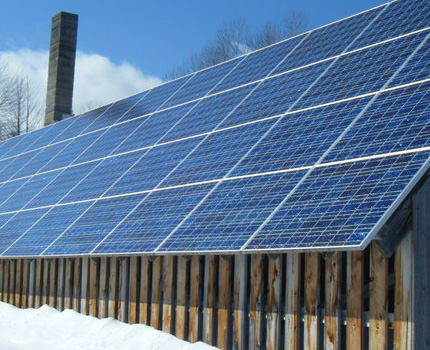
Solar installations have a high coefficient of efficiency. Many efficient owners independently equip their homes with such systems
The principal difference between these converters is that the batteries produce a current that can be used when electric heating a country house. Collectors are used in the system of water and air heating. The most effective option - equipment in the premises of the system of warm floors.
The view that the sun can not cope with the heating of the house is only valid in case of incorrect installation and erroneous calculations of the amount of necessary energy and heat. The optimally selected solar power plant is fully capable of providing heating system. Another question is that for this it will be necessary to invest in the purchase of equipment, its installation and integration into the existing heating system.
Image Gallery
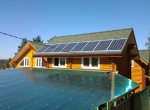
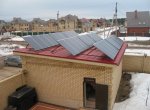
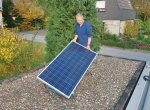
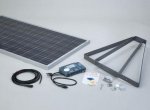
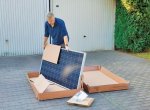


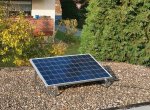
How the collector solar system works and works
The solar system on photovoltaic converters absorbs solar energy, and silicon photocells immediately transform it into a constant electric current. 1 m 2 installation able to produce 120 watts. In addition to panels that capture solar radiation and convert it, a charge controller, a DC-to-AC converter must be installed for the solar heating system, and safety is ensured by putting fuses.
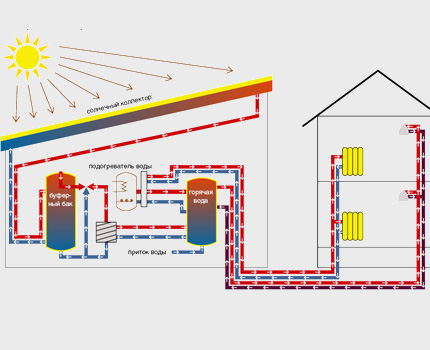
Before deciding to install solar power plants, you need to understand their device and the principle of operation
The advantage of the panels is the ability to connect batteries accumulating excess energy that can be used at night. A significant drawback with the use of helio batteries is their greatest efficiency in the southern regions. In a harsh climate, it is economically inexpedient to install them for use as the main type of heating.
Solar installations equipped with a system of tubes are more suitable for regions with cold winters and a negative temperature. Depending on the structure of the panel and materials, vacuum collectors, flat and concentrators are distinguished. The most expensive among them is with vacuum tubes. But they are the most effective at any time of the year and any weather, because they know how to absorb a wide range of solar radiation. Another advantage is that the vacuum panels function successfully at a negative temperature of -35 ° C.
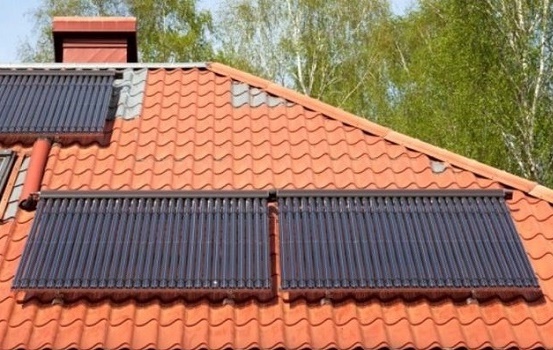
Install solar collectors you can do it yourself, without using the services of organizations specializing in this. Such work will require an assistant, but will save the family budget
The principle of the collector is that it catches the solar radiation, which in vacuum tubes is converted into heat. Then it is transferred to the heat carrier, which delivers it to the heat exchange tank. Then the coolant enters the heating system.
Biofuel as an alternative to tradition
One of the effective and affordable ways to heat a country house is a boiler that runs on bio-pure fuel. This kind alternative heating uses for its work production waste - the husks of crops, chips, sawdust and other by-products of the woodworking industry.
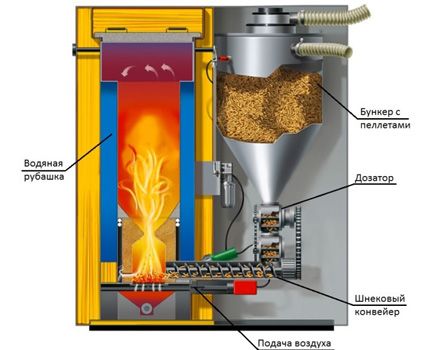
Boilers working on pellets, there are many. There is an opportunity to automate the fuel supply process, so that everything happens without the participation of the host
Of the various wastes, compact compact pellets of small size are made - pellets that are burned in boilers. Compared with conventional firewood, this fuel burns longer and allows you to get more heat. Also, large dense briquettes are made from various kinds of vegetable waste. This compressed fuel allows you to get 2-4 times more thermal energy. Its calorific value is up to 5.0 kWh / kg.
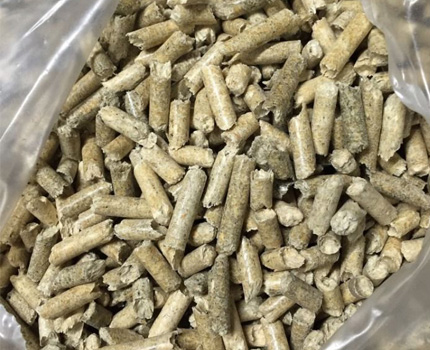
Pellets, in contrast to briquettes, are much smaller. They are used in an automated heating system. Briquettes are more effective, but they have a larger size
For a gas boiler, biogas can be used. It is easy to obtain in the process of rotting organic waste. To do this, it is necessary to build a sufficiently large reservoir, put waste into it, and provide an installation for mixing them. Under the influence of air and bacteria, the process of rotting and gas evolution will occur. A pipeline must be installed to discharge the waste material. Also, to collect gas in special tanks, to clean it and move it to the heating system, you need to use the appropriate tools.
An environmentally friendly method of heating, using an alternative source of heat - a hydrogen boiler. At the heart of his work is the reaction of the interaction of hydrogen molecules with oxygen, during which a huge amount of heat is released. This type of heating requires compliance with operating and safety regulations.
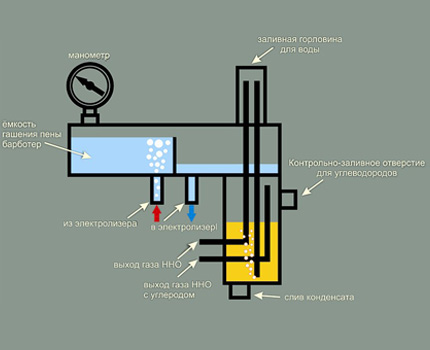
The principle of the hydrogen boiler is based on a chemical reaction between hydrogen and oxygen, resulting in a lot of heat and no harmful substances. But you must follow the safety rules
The main disadvantage is the high cost of factory equipment. The solution to this situation is the equipment of the hydrogen heating system on its own. To work it will require constant connection to electricity and water sources, hydrogen burner, hydrogen generator, catalysts and the boiler itself. The heat obtained as a result of a chemical reaction enters the heat exchanger, and simple water as a waste.
Economical alternative heating
Analyzing the financial component of alternative types of heating, you can come to a disappointing conclusion - you will need considerable funds at the initial stage. Here, after 3-7 years, depending on the chosen heating method, significant savings due to the non-volatile system will become apparent.

It is beneficial and convenient to use a combined source of alternative heating. To do this, you can choose the most optimal combination for your home
It is possible to save on the use and installation of alternative installations for generating heat. Many home masters are very enthusiastic about creating analogs for factory instruments for converting alternative energy by their own hands. So, it is quite simple and inexpensive to assemble a solar installation from a hose, which will serve as an additional source of water heating.
Successfully collected at home small windmills from improvised means. Also, well-read farmers living in rural areas construct facilities for converting biological waste products of plant and animal origin into biogas.
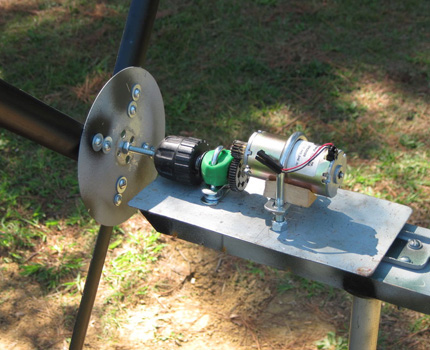
Homemade wind generators are quite workable. But for their assembly it will be necessary to make preliminary calculations, purchase consumables, spend your time
In the future, it is used for the needs of the economy. Depending on the size of the tank for fermenting waste and the area of a private house, it is possible to completely provide the farm with biogas for all needs.
Video about alternative sources of heating
Production roller:
Video about the combination of alternative sources for electricity in a small country house:
A small video on the use of a heat pump:
Video about receiving biogas:
Refuse from traditional sources of heating is quite realistic. To do this, you need to carefully choose an alternative or combine several, based on the characteristics of the area, the area of your country house and local area. The energy of the sun, earth, wind power, utilization of household waste of vegetable and animal origin is quite capable of becoming a worthy substitute for gas, coal, wood and paid electricity.
The rise in price of traditional types of fuel (gas, firewood, electricity, peat, etc.) makes us seek cheaper methods of heating. Traditional boilers are gradually replacing the alternative heating of a private house, allowing thermal energy and at the same time save money.
A few words about alternative heating
Everyone understands the term "alternative heating" in his own way. Someone only includes the use of renewable energy sources, others add infrared heaters, film floors and many other options.
However, the classic alternative home heating as a heat source uses spontaneously-replenished natural resources, which include wind, sun, earth's heat. It is implemented with acceptable for each cost, but in the future there is no need to pay suppliers.
One of the most affordable traditional sources of heat is gas. But its cost is also constantly increasing, increasing the cost of heating. The way out of the situation is alternative heating of a private house, which can be realized in numerous ways. The most common are:
- Wind energy
- Solar systems (solar cells)
- Heat Pumps
- Boilers that use biofuel
Visual example video
Wind power
The energy produced by a special windmill is one of the most popular, since the movement of air masses will never stop. Today, the installation is available to everyone, but they did not receive the proper distribution for objective reasons:
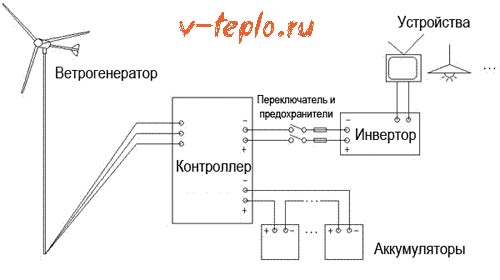
- High cost of equipment and installation
- The need for a large free space for the placement of a large-sized product
In areas in which the winds are exceptionally impetuous and infrequent, the use of wind turbines is economically inexpedient. The obtained mechanical energy can not be directly used for heating the coolant without a special transforming device.
Heliosystems
The most common are solar batteries, which can be used as an alternative heating for a private house. The simplest scheme consists of a circulating pump, a collector and a solar module.
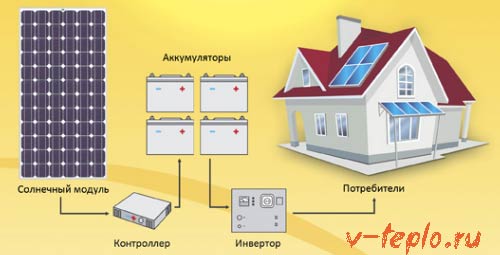
Implement heating using solar silicon modules in one of two ways:
- By means of a water collector
- By means of electric heaters
The first method, in which the energy of the sun is accumulated directly in the electric power and is used to power the heating elements - Tanya. The latter, in turn, are heated in a special container (collector) by a liquid coolant that circulates through the heating system via a pump. To prevent overheating, it is necessary to install thermostats controlling the temperature of the liquid and controlling the operation of the heating elements.
The second method is to use electrical devices as heating elements: heaters, film warm floors, etc. Thus, solar energy is converted into electrical equipment and, through an inverter and controller, it is sent to supply heating devices.

The use of solar energy for many may seem the most optimal and simple options, but do not forget about changing the day or cloudy weather. At such times, the modules may not generate enough electricity.
There is a way out of the situation - it is necessary to purchase and install expensive batteries. They will accumulate energy and supply it during periods when solar modules are idle. The shortcoming consists in a short service life - 5-6 years.
Heat Pumps
The most universal alternative heating for a private house. They work according to the known principle of the refrigerator, taking away the heat from the colder body and giving it away in the heating system.
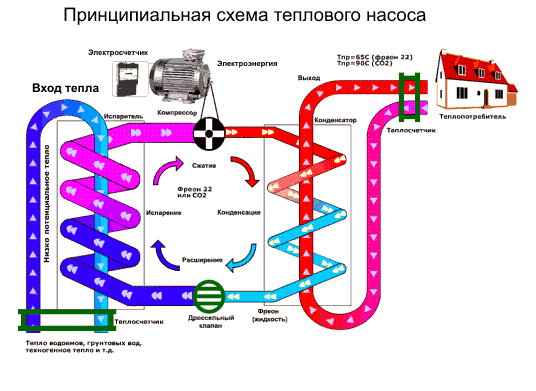
There is a complicated at first glance scheme of three devices: an evaporator, a heat exchanger and a compressor. There are a lot of options for implementing heat pumps, but the most popular are:
- Air-to-Air
- Air-to-water
- Water-to-water
- Ground-water
Air-to-Air
The cheapest option is "air-to-air". In fact, it resembles a classic split-system, but the energy is spent only on pumping heat from the street into the house, and not to heat the air masses. This helps to save money, while perfectly heating the house throughout the year.
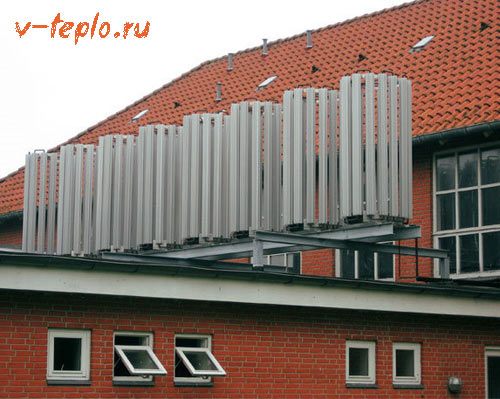
The efficiency of the systems is very high. For 1 kW of electricity, you can get up to 6-7 kW of heat. Modern inverters work fine even at temperatures of -25 degrees and below.
Air-to-water
Air-to-water is one of the most widespread implementations of a heat pump, in which the coil of a large area, which is installed in an open area, plays the role of a heat exchanger. In addition, it can be blown by a fan, causing the water to cool down inside.

Such installations are characterized by more democratic cost and simple installation. But they are able to work with high efficiency only at temperatures from +7 to +15 degrees. When the column drops to a negative mark, the efficiency falls.
Ground-water
The most universal realization of the heat pump is "ground-water". It does not depend on the climatic zone, since a layer of soil that does not freeze throughout the year is everywhere.
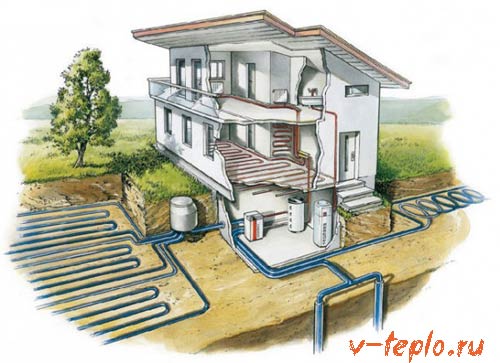
In this scheme, the pipes are immersed in the earth to a depth where, throughout the year, the temperature is held at 7-10 degrees. Collectors can be located vertically and horizontally. In the first case, it is necessary to drill several very deep wells, in the second - to lay the coil at a certain depth.
The shortcoming is obvious: complex assembly works, which will require high financial investments. Before deciding on such a step, one should calculate the economic benefit. In areas with short warm winters, it is worth considering other options for alternative heating of private houses. Another limitation is that a large free area is needed - up to several tens of square meters. m.
Water-to-water
The implementation of the water-to-water heat pump is practically the same as the previous one, but the collector pipes are laid in groundwater, which do not freeze throughout the year, or a nearby pond. It is cheaper due to the following advantages:
![]()
- The maximum drilling depth of the well is 15 m
- You can do 1-2 submersible pumps
Boilers, working on biofuel
If there is no desire and the opportunity to equip a complex system consisting of pipes in the ground, solar modules on the roof, you can replace the model that operates on biofuel. They need:

- Biogas
- Straw pellets
- Peat granules
- Chips, etc.
Main advantages
When deciding on the installation and subsequent operation of alternative sources of heat energy, it is necessary to answer the question: how quickly will they pay off? Of course, the systems considered have advantages, among which are:
- The cost of energy is less than using traditional sources
- High efficiency
However, one should remember the high initial material costs, which can reach tens of thousands of dollars. Installation of such installations can not be called simple, therefore, the work is entrusted exclusively to a professional team that is able to provide a guarantee for the result.
Summing up
Demand for alternative heating private house, which becomes more profitable against a background of expensive traditional sources of thermal energy. However, before you begin to convert the current heating system, you need to calculate everything by considering each of the proposed options.
Refuse from the traditional boiler is also not recommended. It must be left in certain situations, when alternative heating does not fulfill its functions, it will be possible to warm your house and not freeze
In an environment where energy resources are constantly becoming more expensive, alternative heating of a private home becomes relevant. Owners of cottages and cottages are looking for acceptable options for heating their property, considering a variety of proposals: from solid fuel boilers to solar collectors. Each type of heating, which differs from the standard, has certain advantages and disadvantages. We will talk about them today.
For some homeowners, any opportunity to abandon the usual gas heating in rural areas can be a suitable alternative. Others seek full autonomy and look to the possibilities of accumulating and using solar energy.
Environmental advocates stand for environmentally friendly energy of land and water. Some are concerned about how the air in the house warms up and how the heaters affect the humidity in the room.
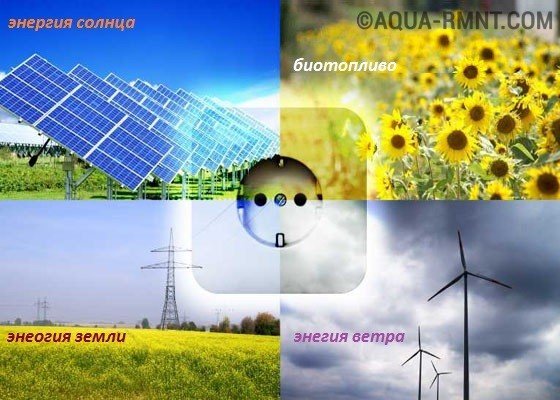
The use of natural energy sources is currently quite expensive and pays off, as a rule, for ten years or more
In general, modern alternative types of heating look quite diverse:
- boilers operating on solid or liquid fuels, as well as biofuels;
- heat pumps, based on the use of geothermal energy;
- solar collectors using the thermal energy of the sun;
- infrared heaters of various types;
- "A warm plinth."
Until recently, the alternative methods of heating included systems such as "warm floor", which appeared on the market not so long ago. Today they have become quite familiar and perfectly complement, and at times completely replace the usual methods of heating with the help of radiators.
It would seem that the use of a gas boiler for heating a private house has many advantages. Many thousands of homes are heated that way. However, the requirements of homeowners for the quality of heating are constantly growing.
It is worth noting that it is not so easy to connect a gas boiler to the main line technologically. Problems arise in the process of processing all relevant documents. In addition, the cost of gas is constantly growing. Finally, the quality of heat also causes criticism. With the help of a boiler it is difficult to heat the house evenly: the temperature of the radiators and the floor is much higher than in the center of the room.
Option # 1 - boiler on biofuel
To abandon the gas and replace it with another energy source, it is enough to change the boiler. The most popular options are electric and solid fuel. But heating the energy carrier with electricity is not always economically viable.
An interesting option may be the use of biofuel boilers. For their work, special briquettes and pellets are used, but such materials as:
- wood pellets and chips;
- granulated peat;
- granules from straw, etc.
Using briquettes allows you to make the fuel supply to the boiler automatic, you will no longer need to take care of it. However, it should be noted that the cost of such a boiler can be ten times higher than the prices for gas analogs, briquettes are also quite expensive.
Please note that a properly arranged fireplace is a good alternative to modern heating methods. It is quite capable of effectively heating a small cottage.
Option # 2 - application of heat pumps
Geothermal heat pumps heat the house using the energy of the earth or water. In summer, such a system operates as an air conditioner, i.e. helps to cool the building, returning excess heat to the ground. This is an environmentally friendly type of heating, in which renewable resources are used.
If we compare the cost of heating with heat pumps with gas boilers, we can note a noticeable saving: about 15%. However, alternative heating systems of this type are rare, since the costs of their creation remain very high.
Please note that for the heat pump to work, you need a constant supply of electricity. Therefore, you should not mount such a system in a locality where electricity is often cut off. Solve this problem with the help of its own generator, but as a result, significantly increase the cost of installation and maintenance.
Option # 3 - use of solar collectors
These are the plates that are usually installed on the roof of the house. They accumulate the heat of the sun's rays and transfer the collected energy to the boiler room with the help of a coolant. Heat enters the heat exchanger, which is built into the accumulator tank. After that, the water is heated and can be used for heating, domestic needs, swimming pool, etc.

Solar collectors can work effectively at low temperatures and cloudy weather
Thanks to new technologies, solar collectors are able to receive heat even in cloudy weather or when the air temperature is below zero. However, the maximum effect from their use can be obtained in the southern regions, where the amount of solar radiation is quite high. In the colder terrain, helio-collectors will better cope with the role of additional, rather than basic, heating.
Option # 4 - infrared heating
Infrared heating is becoming more widespread. Such alternative heating sources at home are relatively inexpensive and very easy to install. Compact infrared heaters effectively heat the room, in addition, they can decorate the interior.
No less popular infrared film, which is used when installing the system "". It is laid under a layer of decorative floor covering, which greatly facilitates installation. Do not need complicated repairs, just remove the floor covering, lay the film and lay a new coating.
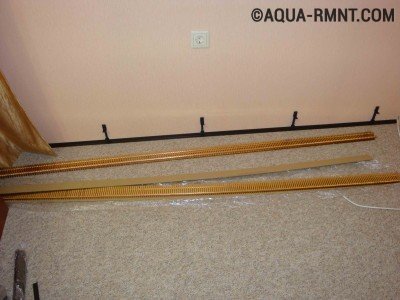
Warm plinth allows you to warm the room efficiently and evenly
Also, an interesting solution for a home can be a system called "". This system is mounted along the walls, which are heated first and radiate heat inside the room, preventing its penetration outside. As a result, the air temperature in the room becomes very uniform.
These alternative sources of heating a country house also do not require too much to purchase. And their installation is simple. For example, electrical system A warm skirting board can be installed literally in a couple of days. It does not need to install additional communications, which means that the interior of the house will not suffer. When using such heating, the humidity in the rooms remains optimal.
Similar entries:
2015-04-21 12:54:49
Please tell me which version of the collector your friend chose and maybe you already? What firm, capacity, for what area and how much it cost.

